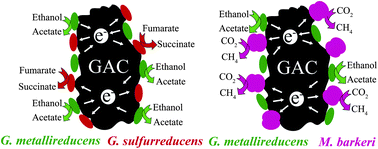Granular activated carbon (GAC) is added to methanogenic digesters to enhance conversion of wastes to methane, but the mechanism(s) for GAC's stimulatory effect are poorly understood. GAC has high electrical conductivity and thus it was hypothesized that one mechanism for GAC stimulation of methanogenesis might be to facilitate direct interspecies electron transfer (DIET) between bacteria and methanogens. Metabolism was substantially accelerated when GAC was added to co-cultures of Geobacter metallireducens and Geobacter sulfurreducens grown under conditions previously shown to require DIET. Cells were attached to GAC, but did not aggregate as they do when making biological electrical connections between cells. Studies with a series of gene deletion mutants eliminated the possibility that GAC promoted electron exchange via interspecies hydrogen or formate transfer and demonstrated that DIET in the presence of GAC did not require the electrically conductive pili and associated c-type cytochrome involved in biological interspecies electrical connections. GAC also greatly stimulated ethanol metabolism and methane production in co-cultures of G. metallireducens and Methanosarcina barkeri. Cells were attached to GAC, but not closely aggregated, suggesting little opportunity for biological electrical contacts between the species. GAC also enhanced methane production in samples from a methanogenic digester in which Methanosaeta were the predominant methanogens. The results demonstrate that GAC can promote DIET and suggest that stimulation of metabolism in methanogenic digesters can be attributed, at least in part, to the high conductivity of GAC providing better interspecies electrical connections than those that can be forged biologically.

You have access to this article
 Please wait while we load your content...
Something went wrong. Try again?
Please wait while we load your content...
Something went wrong. Try again?


 Please wait while we load your content...
Please wait while we load your content...